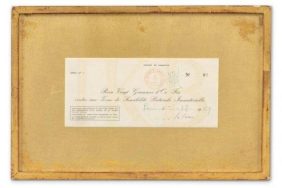Artwork: Postcard view of l’impasse Ronsin from the Barthod Collection, ca. 1915-1916.
Up in the hills of Montparnesse, Paris, lies a backstreet that goes by the name Impasse Ronsin. It is neatly tucked away, discreetly connecting a hospital morgue to the closest thoroughfare. It is rather fitting, given the actions of a local resident who made the street a site of notoriety for years to come. Over a century ago, Marguerite Steinheil lived on this block, a femme fatale whose lovers included Monsieur Félix Faure, who was then the President of France.
Also: Join Toyo Tsuchiya on a Wild Ride Through New York’s “Invisible Underground”
In February 1899, a 20-year old Steinheil was invited for a tryst at the Palais de l’Élysée; Faure died later that day. Legend has it that he died while receiving oral sex. This bode well for Steinheil’s reputation as her services became quite in demand. But life doesn’t always work out like we might expect. In 1908, Steinheil’s husband and stepmother were founded at their residence in the Impasse Ronsin: the husband strangled, the stepmother suffocated on her false teeth.

L’impasse Ronsin, early 20th C. Courtesy of Paul Kasmin Gallery
Steinheil was discovered gagged and bound to the bed. She claimed four black-robed strangers were responsible for the murders. But then she was caught trying to frame her manservant for the crimes, and when that failed, she went after the son of her old housekeeper—only to have her actions backfire. Steinheil was arrested and the crime became an international sensation but she was later acquitted and set free.
With a pedigree like that, it’s easy to imagine the morbid allure of the Impasse Ronsin at the time. Artists, who had been settling into the Left Bank, found their way to this little, inexpensive corner of the city. By 1916 sculptor Constantin Brancusi set up shop, creating the cornerstone for an artistic community that would flourish for decades to come; Brancusi remain on site until his death in 1957. His studio attracted artists from all walks of life including William N. Copley, Max Ernst, Yves Klein, Les Lalanne, Larry Rivers, Niki de Saint Phalle, and Jean Tinguely, among others, to this curious little corner of the world.

Atelier Brancusi L’entrée 1, 11, Impasse Ronsin, 1956, 1956, 9 7/8 x 8 1/8 inches 25.2 x 20.4 cm (PK 22603) Description/commentary: Studio_Entry, original photo 1956, 252 x 204 mm. On the back, marked by ND’s handwriting:”Atelier Brancusi, 1956 L’entrée 1, 11, Impasse Ronsin
Impasse Ronsin grew to become one of the central areas for the development of Dada and Surrealism from the 1930 through the 1950s. Yet, at the same time, it was the height of anti-glamour, being something a cesspool. There was no sanitation, plumbing, or heating except for what remained at Steinheil’s former abode. By the 1950s, the French government declared the studios uninhabitable but did not shut them down. Perhaps they were simply to valuable in a way that could not be quantified.
Impasse Ronsin attracted artists like Man Ray and Marcel Duchamp who frequently passed by though neither maintained a studio. It became the place where a 22-year-old Isamu Noguchi apprenticed under Brancusi. It was here that Niki de Saint Phalle, a former model, staged her “Shooting Paintings” with the help of Jean Tinguely, Yves Klein and Pierre Restany. Using a .22 rifle, she shot up bags that held pockets of paint, creating a work of performance art as well as a finish painting that challenged traditional ideas of the artist’s role.

Max Ernst sitting, impasse Ronsin, 1954. Photo: Douglas Glass, © J.C.C. Glass.
In celebration of this legendary locale, Paul Kasmin Gallery, New York, presents Impasse Ronsin, on view now through January 14, 2017. The exhibition features a selection of works by the artists of Impasse Ronsin in an elaborate installation designed to embody the energy of the setting. The show deftly combines artwork and archival photographs to produce a dialogue between the space, the artists, and the work they produced.
Included in the exhibition are feature a bronze edition of Princess X, one of Brancusi’s most iconic forms, a vintage photograph of Brancusi and his dogs taken at the Impasse by Man Ray, an original set of Duchamp’s “Rotoreliefs” and his film Anemic Cinema (1926), William N. Copley’s Steroptic Nude, one of the artist’s most important early paintings, Niki de Saint Phalle’s Tir (Fragment de Dracula II) (1961) a kinetic sculpture made by Larry Rivers with the help of Jean Tinguely titled Turning Friendship Model (1961), an installation that evokes the “Brancusi-like” studio Isamu Noguchi established in Gentily in 1927 created by The Noguchi Museum.

Sheet-metal mail boxes (26 x 17.5 x 12 cm) made by Brancusi for the workshops at the impasse Ronsin. Collection Istrati-Dumitresco. © Succession Brancusi – All rights reserved ADAGP, Paris/Artists Rights Society (ARS), New York.
As artist communities flourish around the globe today, the story of Impasse Ronsin holds a sacred place in the history of modern art. It reminds us of the ways in which artists live in dialogue: with their art, with their surroundings, and with each other. The purpose of community is to help us bare the weight of the trials and tribulations of life through camaraderie and competition alike. Impasse Ronsin was a magical place where strong minds could find themselves in daily conversation about ideas, innovations, and practices. It was as rare a phenomenon as it was effective providing decades of nourishment to the rare minds willing to break all the rules in order to master the form.
Miss Rosen is a New York-based writer, curator, and brand strategist. There is nothing she adores so much as photography and books. A small part of her wishes she had a proper library, like in the game of Clue. Then she could blaze and write soliloquies to her in and out of print loves.






